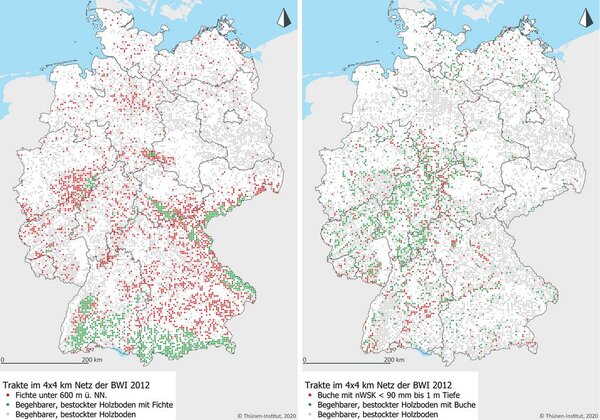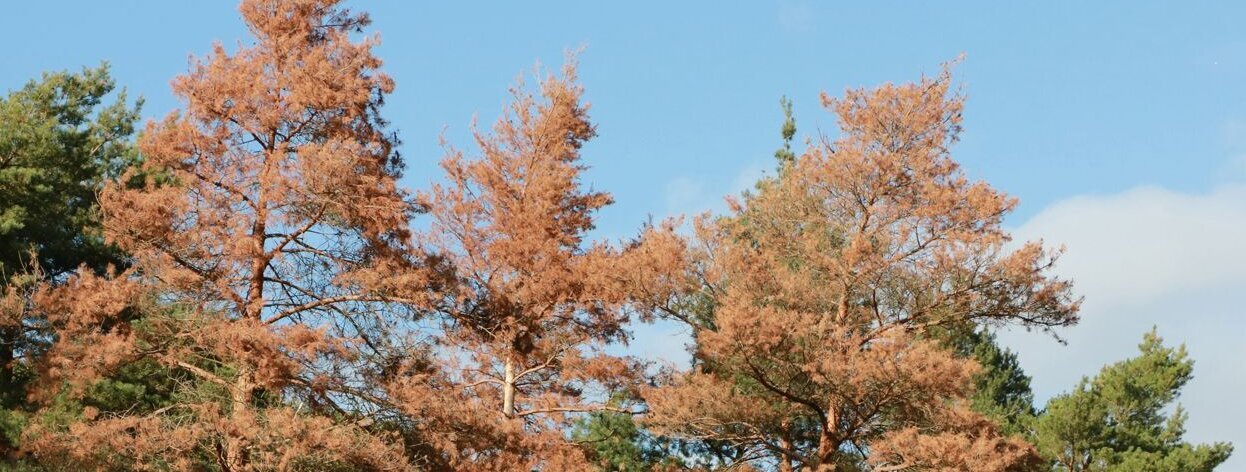FAQ
Forest damage due to drought and heat
Andreas Bolte, Tanja Sanders, Nicole Wellbrock | 22.03.2024
Forests in Germany are suffering from the recurring hot and dry weather conditions. Abundant rainfall like in the winter of 2023/24 provides short-term relief. But even a dry spring like the current one will be a challenge for young trees. Questions and answers about forests and drought can be found in this FAQ.
The term "forest dieback" is misleading. The current damage affects individual trees, groups of trees and, in the case of spruce, stands. However, the forest does not disappear, but other trees can use the resulting gaps. Therefore, the forest ecosystem remains. In larger areas, with dead trees, planting is used to aid regeneration. However, dealing with the current damage requires a great deal of logistical and economic effort, which poses significant challenges for the forestry industry.
The current damage is also not primarily caused by air pollutants and acid rain as it was in the 1980s but by climate change and intensifying extreme weather. The long-term solution, therefore, is to drastically reduce greenhouse gas emissions to limit warming.
The current damage shows as a cascading effect, starting with the storms in the fall of 2017 and spring of 2018 producing a large amount of dead wood. Insects, for example bark beetles, then benefited from the very dry and hot summers of 2018 to 2020 and 2022. The current damaged area of just under 500,000 hectares (as of March 2023) corresponds to around a third of the land area of Schleswig-Holstein.
Strong storms like Vivian and Wiebke (year 1991), Lothar (1999/2000) and Kyrill (2007) were the damage drivers in Germany's forests until 2018. Since 2019, on the other hand, insects in particular have been causing a record amount of damaged wood.
In 2020, the proportion of damage-related logging in Germany was at a record level of around 75 per cent (see chart). Since then, the proportion has been slowly falling again but remains at a high level of more than 50 percent.
The causes of damage are different for each tree species. In the case of spruce - the tree species with by far the highest proportion of damage - bark beetles (spruce bark beetle, copper engraver) are mainly responsible for the damage. These were able to spread further in weakened spruce stands due to the already significant damage in 2018.
Vital spruce trees can defend themselves against initial infestations by resin that surrounds beetles at the point of entry, but not against mass infestations. Drought, however, causes spruce to produce less resin.
Beech trees have been damaged by the direct effects of heat (leaf damage, sunburn) and drought (crown wilt). Fungi and other pests such as the beech bark beetle can then cause the trees to die. Drought and a variety of different pests also interact in pines and oaks.
The cool and wet weather in 2021 but also in the winter of 2023/2024, replenished the soil water reserves of the upper forest soil layers. This had a positive effect on the water balance, especially during leaf unfolding. Young and newly planted trees in particular benefit from the high topsoil moisture.
The DWD's interactive soil moisture map also shows a relaxation in the deeper soil layers in many regions. However, in some areas (e.g. Sachsen-Anhalt) the drought still extends into deeper soil layers.
The cool weather also inhibited insect pests from developing. The swarming season of bark beetles was delayed several weeks in the spring of 2021. However, the bark beetle population is so high that mass reproduction occurred again in 2022.
Vitality indices from remote sensing products continue to show a low vitality of the stands. This is also confirmed by the results of the forest condition survey.
The damage to forestry is huge, especially in the case of spruce. The trees infested by the bark beetle must be felled as quickly as possible and transported out of the forests. The damaged timber can only be sold at a discount due to the current oversupply but at the same time reforestation must be financed.
The spruce damage will probably also have negative consequences for the climate protection function of the forests. As a fast-growing native tree species, spruce provides 40 per cent of the timber growth and 50 per cent of the harvested timber volumes in Germany. This means that spruce growth makes a very important contribution to carbon sequestration in the forest stand and in wood products. The loss of fast-growing spruce stands can reduce the climate protection effect.
In the medium and long term, a change in the composition of tree species is to be expected.

Climate change, with its more frequent heat and drought extremes, is expected to change the tree species composition. A risk analysis by the Thünen Institute indicates that about 2.85 million hectares of current forest stands (25% forest area share) are particularly sensitive to drought and subsequent pest infestation due to their tree species composition. These stands must continue to be actively converted and managed in such a way that they remain climate resilient in the future, i.e. are not acutely endangered by the advancing climate change. Forests that have already been converted should be managed so that they remain climate resilient. Funding requirements for conversion are estimated to range from 13 to 43 billion euros over the next 30 years. Annual conversion area would need to quadruple to 95,000 hectares to meet conversion targets by 2050.
Mixed forests with different tree species can reduce the risks of damage. Mixing in trees of our native tree species, such as beech or oak, that originate from the dry-warm distribution edge in southern (eastern) Europe can also increase forest adaptation.
Especially on drier and warmer sites, the expansion of the tree species palette
- with native tree species from drier or continental climates such as sweet chestnut, lime trees, hornbeam, wild fruit species, downy oak, service tree
- with introduced tree species from southern (eastern) Europe such as Hungarian oak, Turkey oak, hop hornbeam, oriental beech or
- with introduced species from overseas with distribution in summer-dry climates such as Douglas fir, coastal fir or red oak.
In this context, it is an important task of science and practice to develop a tree species selection, tree species mixture and stand treatment optimized for the future climate.
More information in: Bolte et al. AFZ Der Wald 4/2021 (in German)








